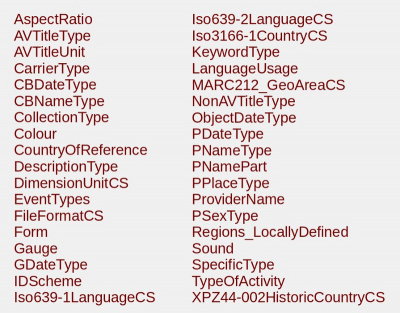Difference between revisions of "Where to look for suitable vocabularies"
From filmstandards.org
| (2 intermediate revisions by the same user not shown) | |||
| Line 7: | Line 7: | ||
{| style="float: right; border: 1px solid #BBB; margin: .46em 0 0 .2em;" | {| style="float: right; border: 1px solid #BBB; margin: .46em 0 0 .2em;" | ||
|- | |- | ||
| − | | width=" | + | | valign="top" width="405px" |[[File:Efg-type-vocs.jpg|400px]]<br /> |
| − | + | <span style="font-size:8pt"> | |
| + | </span> | ||
| + | |||
| + | | valign="top" width="405px" | | ||
| + | This is a list of '''type vocabularies''' for the European Film Gateway (EFG) metadata schema. These vocabularies were collected from various sources, including existing filmographic databases. | ||
| − | + | EFG uses these vocabularies as ''mapping targets'', i.e. as a common representation for data values expressed in locally defined vocabularies of contributing film archives. | |
| − | + | |} | |
| − | |||
| − | |||
{| style="float: right; border: 1px solid #BBB; margin: .46em 0 0 .2em;" | {| style="float: right; border: 1px solid #BBB; margin: .46em 0 0 .2em;" | ||
|- | |- | ||
| − | | valign="top" width="405px" |[[ |400px]]<br /> | + | | valign="top" width="405px" |[[File:Efg-rel-vocs.jpg|400px]]<br /> |
<span style="font-size:8pt"> | <span style="font-size:8pt"> | ||
</span> | </span> | ||
| valign="top" width="405px" | | | valign="top" width="405px" | | ||
| − | + | These are '''relationship vocabularies''' from the European Film Gateway (EFG) project. As an example, the ''AVManifestationRelation'' defines the ways in which a manifestation of an audiovisual work can be related to an instance of an audiovisual creation. | |
| + | |||
| + | Note that the distinction between type and relationship vocabularies is not always obvious. | ||
|} | |} | ||
| + | {| style="float: right; border: 1px solid #BBB; margin: .46em 0 0 .2em;" | ||
| + | |- | ||
| + | | width="810px" style="background-color:#F0F0F0" | | ||
| + | Vocabulary collections | ||
| + | |||
| + | * [http://www.loc.gov/standards/sourcelist/ MARC Source Codes for Vocabularies, Rules, and Schemes] | ||
| + | * [http://metadataregistry.org/vocabulary/list.html The Open Metadata Registry vocabulary collection] | ||
| + | * [http://www.ebu.ch/metadata/cs/ EBU metadata coding schemes download page] | ||
| + | * [http://schema.org/docs/full.html schema.org: A collection of markup vocabularies from the major search engine providers] | ||
Latest revision as of 08:41, 23 October 2011
From the TC 372 Workshop Compendium
Strictly speaking, even a metadata schema such as EN 15907 is a vocabulary. It provides us with names and definitions of entities. In addition, it defines ways in which these entities can be combined in order to create meaningful statements. This is its role as a syntax definition.
In a syntax definition (also known as grammar), each element denotes a class of vocabulary items. In cases where the element has the syntactical role of a noun or adjective, this class will be referred to as type vocabulary. If the class members are expected to be verbs or verb phrases (including all constructs containing the verb to be), then we speak of a relationship vocabulary. And finally, where the element denotes a class of named entities (e.g. persons, product names, etc.), we use the term name authority file, a concept borrowed from librarianship.
| • Previous: Common pitfalls in vocabulary selection • Up: Contents • Next: Titles and proper names • |

